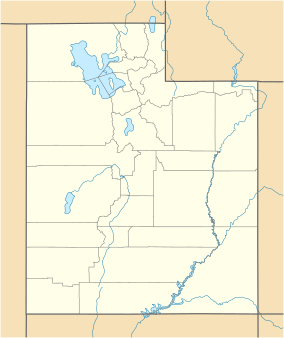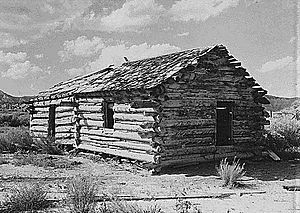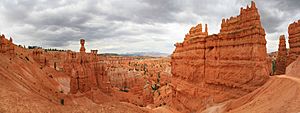Bryce Canyon National Park facts for kids
Quick facts for kids Bryce Canyon National Park |
|
|---|---|
|
IUCN Category II (National Park)
|
|
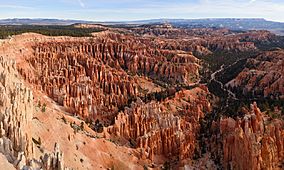 |
|
| Location | Garfield County and Kane County, Utah, United States |
| Nearest city | Tropic, Panguitch |
| Area | 35,835 acres (145.02 km2) |
| Established | February 25, 1928 |
| Visitors | 2,354,660 (in 2022) |
| Governing body | National Park Service |
Bryce Canyon National Park is a special national park in southwestern Utah, USA. It's famous for its unique rock formations called hoodoos. These hoodoos are tall, colorful spires of rock, shaped by wind and water over millions of years.
Even though it's called a "canyon," Bryce Canyon isn't a true canyon. Instead, it's a series of huge natural amphitheaters carved into the side of a high plateau. The rocks here are red, orange, and white, making for amazing views. Bryce Canyon is smaller and higher up than nearby Zion National Park. The rim of the canyon is about 8,000 to 9,000 feet (2,400 to 2,700 meters) high.
The park is located in parts of Garfield County and Kane County. Mormon pioneers settled this area in the 1850s. The park was named after Ebenezer Bryce, who lived here in 1874. It became a national monument in 1923 and a national park in 1928. Bryce Canyon National Park covers about 35,835 acres (145 square kilometers). In 2023, over 2.4 million people visited the park.
Contents
Exploring Bryce Canyon's Geography
Bryce Canyon National Park is in southwestern Utah. It's about 50 miles (80 km) northeast of Zion National Park. Bryce Canyon sits about 1,000 feet (300 meters) higher than Zion.
The park is part of the Colorado Plateau region. It's on the edge of the Paunsaugunt Plateau. Paunsaugunt means "home of the beaver" in the local Paiute language. When you visit, you look out from the plateau's edge. You can see a valley with the Paria River below. Paria means "muddy or elk water."
Bryce Canyon's unique shape comes from erosion. Water and ice slowly carved out huge, bowl-shaped areas called amphitheaters. These aren't like canyons formed by a single river. This erosion created the tall, colorful hoodoos. Some hoodoos are as tall as 200 feet (60 meters)!
The park has many amphitheaters stretching over 20 miles (32 km). The biggest is Bryce Amphitheater. It's 12 miles (19 km) long, 3 miles (5 km) wide, and 800 feet (240 meters) deep. You can see similar hoodoos at Cedar Breaks National Monument nearby.
Rainbow Point is the highest spot in the park. It's 9,105 feet (2,775 meters) high. It's at the end of the 18-mile (29 km) scenic drive. From here, you can see far-off places like the Henry Mountains. The lowest part of the park is Yellow Creek, at 6,620 feet (2,018 meters).
Weather and Climate at Bryce Canyon
The weather at Bryce Canyon is generally cool. It gets more rain and snow than Zion National Park. The park receives about 15 to 18 inches (380 to 460 mm) of precipitation each year.
Temperatures change a lot throughout the year. In January, the average low is about 9°F (-13°C). In July, the average high is around 83°F (28°C). But temperatures can be much colder or hotter. It can drop to -30°F (-34°C) in winter or reach 97°F (36°C) in summer.
The park gets a lot of sunshine, especially in summer. It also gets plenty of snow in winter. This makes it a beautiful place to visit year-round.
A Look at Bryce Canyon's History
Early People in the Area
People have lived in the Bryce Canyon area for at least 10,000 years. Scientists have found old tools and items from the Basketmaker and Anasazi people. These groups lived here thousands of years ago.
Later, the Paiute Native Americans moved into the area. They hunted animals and gathered plants for food. They also grew some crops. The Paiute people had a special story about the hoodoos. They believed the hoodoos were "Legend People" turned to stone by a trickster spirit named Coyote. An older Paiute person said their name for the hoodoos was Anka-ku-was-a-wits. This means "red painted faces."
European Settlers Arrive
In the late 1700s and early 1800s, the first European Americans explored this area. Mormon scouts came in the 1850s. They wanted to see if the land was good for farming and raising animals.
A big scientific trip happened in 1872. It was led by U.S. Army Major John Wesley Powell. His team mapped the area and studied its geology. They used many Paiute names for places on their maps.
Small groups of Mormon settlers then tried to live near Bryce Canyon. In 1873, a cattle company started grazing cows there.
The Church of Jesus Christ of Latter-day Saints sent Ebenezer Bryce and his wife Mary to settle in the Paria Valley. Ebenezer Bryce was a carpenter. His family settled right below the main group of hoodoos, now called Bryce Amphitheater. Bryce grazed his cattle inside what is now the park. He famously said the amphitheaters were a "helluva place to lose a cow." He built a road and a canal to help his farm. Other settlers started calling the area "Bryce's Canyon," and the name stuck.
Later, a mix of dry weather, too many animals grazing, and floods made most settlers leave. Ebenezer Bryce and his family moved to Arizona in 1880.
Becoming a National Park
In the early 1900s, magazines started writing about the beautiful Bryce Canyon. This made more people interested in visiting. But it was hard to get there, and there weren't many places to stay.
Some people started offering tours and places to stay. The Union Pacific Railroad also wanted to bring tourists to southwestern Utah by train.
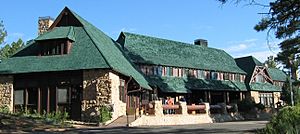
People became worried about damage to the canyon from too many animals and visitors. A movement began to protect the area. The Director of the National Park Service, Stephen Mather, suggested making it a state park. But Utah's governor and lawmakers wanted it to be a national park.
President Warren G. Harding agreed. On June 8, 1923, he made Bryce Canyon a National Monument. A road was built that year to help visitors see the views. From 1924 to 1925, the Bryce Canyon Lodge was built using local wood and stone.
In 1924, Congress started working to make Bryce Canyon a national park. It took four years to get all the land needed. Finally, on February 25, 1928, Bryce Canyon officially became a national park.
More land was added in 1931 and 1942, bringing the park to its current size of 35,835 acres. The Civilian Conservation Corps built the scenic Rim Road in 1934. Until 1956, the park was managed from Zion National Park. Then, Bryce Canyon got its own superintendent.
Recent Years
The Bryce Canyon Natural History Association (BCNHA) started in 1961. This group helps the park by running the bookstore and supporting educational programs.
To help with crowded roads, the park started a shuttle bus system in 2000. This helps visitors get around easily, especially in the busy summer months.
How Bryce Canyon's Geology Formed

The rocks you see at Bryce Canyon were formed from layers of soil and sand. These layers were laid down over millions of years. This happened during the late Cretaceous period and the first half of the Cenozoic era. The area was sometimes covered by warm, shallow seas.
Over time, the land was pushed up by powerful forces. This uplift created cracks in the rocks. Water and ice then worked their magic. They slowly eroded the softer rock layers. This process created the amazing hoodoos. The harder rock layers formed taller, more solid shapes.
The bright colors of the rocks come from different minerals. The red and orange colors are from hematite, which is a type of iron rust. Yellows come from limonite, another iron mineral. Purple colors are from pyrolusite.
Animals and Plants of Bryce Canyon

More than 400 types of native plants grow in Bryce Canyon. The types of plants change with how high up you are.
- At lower elevations, you'll find small forests of pinyon pine and juniper trees.
- Mid-elevations have Ponderosa pine forests. You might also see blue spruce and Douglas fir where there's more water.
- On the high Paunsaugunt Plateau, there are forests of Douglas fir, white fir, and Engelmann spruce.
- In the toughest areas, you can find limber pine and very old Great Basin bristlecone pine trees. Some of these trees are over 1,600 years old!
The park's forests and meadows are home to many animals. You might see foxes, badgers, porcupines, elk, skunks, black bears, bobcats, and woodpeckers. Mule deer are the most common large animals. Sometimes, pronghorn (a type of antelope) also visit the park.

Bryce Canyon is also home to three species protected by law: the Utah prairie dog, the California condor, and the southwestern willow flycatcher. The park has the largest protected group of Utah prairie dogs.
About 170 kinds of birds visit the park each year. Most birds fly to warmer places in winter. But some, like jays, ravens, and eagles, stay all year. In winter, animals like mule deer and cougars move to lower, warmer areas. Ground squirrels and marmots sleep through the winter.
You can also find 11 types of reptiles and 4 types of amphibians. These include the Great Basin rattlesnake and the tiger salamander.
The park also has special "cryptobiotic soil." This is a living crust made of tiny plants like lichens and algae. It helps stop erosion, adds important nutrients to the soil, and helps the soil hold water.
Things to Do at Bryce Canyon
Most visitors drive the scenic road. It has 13 viewpoints where you can stop and admire the amphitheaters.
The park has over 50 miles (80 km) of hiking trails. Here are some popular day hikes:
- Easy to Moderate Hikes:
- Mossy Cave (1 hour)
- Rim Trail (5–6 hours, along the canyon rim)
- Bristlecone Loop (1 hour, at Rainbow Point)
- Queens Garden (1–2 hours, from Sunrise Point)
- Moderate Hikes:
- Navajo Loop (1–2 hours, from Sunset Point)
- Tower Bridge (2–3 hours, north of Sunrise Point)
- Strenuous Hikes:
- Fairyland Loop (4–5 hours, from Fairyland Point)
- Peekaboo Loop (3–4 hours, from Bryce Point)
Many trails connect, so you can make longer, more challenging hikes if you want.
For overnight trips, there are two trails: the 9-mile (14 km) Riggs Spring Loop Trail and the 23-mile (37 km) Under-the-Rim Trail. You need a special permit to camp overnight in the backcountry.
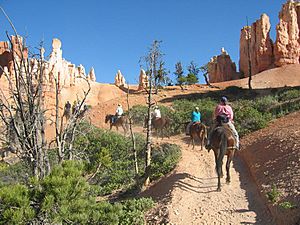
In winter, you can go skiing on over 10 miles (16 km) of marked trails. There are also 20 miles (32 km) of groomed ski trails nearby.
The air at Bryce Canyon is incredibly clear. On most days, you can see Navajo Mountain in Arizona, about 90 miles (145 km) away! On very clear days, you might even see the Black Mesas in New Mexico, about 160 miles (257 km) away.
Bryce Canyon has one of the darkest night skies in North America. You can see about 7,500 stars here! In most cities, you can only see a few dozen stars because of light pollution. Park rangers often host events where you can learn about astronomy and look at the stars. The Bryce Canyon Astronomy Festival, usually in June, is very popular. An Asteroid 49272 was even named after the park!
If you want to stay overnight, the park has two campgrounds: North Campground and Sunset Campground. Loop A of North Campground is open all year. The 114-room Bryce Canyon Lodge is another option for staying inside the park.
Images for kids
See also
 In Spanish: Parque nacional del Cañón Bryce para niños
In Spanish: Parque nacional del Cañón Bryce para niños


